Chapter 5.1 / Climate System
Climate System
The purpose of this section is to explain the climate system. An understanding of how the climate system works to maintain the Earth's energy balance is necessary to understand how the changes we see in our environment are forcing warming and other related changes that are collectively known as climate change.
Professional Development for Educators
Climate System
What controls Earth’s climate?
The image below is an illustration of the interdependent aspects of the Earth's climate system relative to the Earth's energy balance.
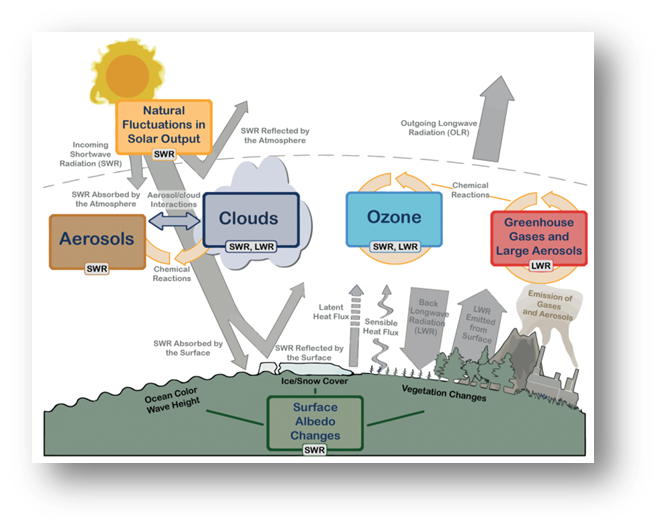
Source: Cubasch, U., D. Wuebbles, D. Chen, M.C. Facchini, D. Frame, N. Mahowald and J.-G. Winther, 2013: Introduction. In: Climate Change 2013: The Physical Science Basis. Contribution of Working Group I to the Fifth Assessment Report of the Intergovernmental Panel on Climate Change [Stocker, T.F., D. Qin, G.-K. Plattner, M. Tignor, S.K. Allen, J. Boschung, A. Nauels, Y. Xia, V. Bex and P.M. Midgley (eds.)]. Cambridge University Press, Cambridge, United Kingdom and New York, NY, USA, pp. 119–158, doi:10.1017/CBO9781107415324.007.
The video below provides an overview of the Earth's climate system.
The climate of the Earth is controlled by the Earth’s energy balance, which is the movement of energy into and out of the Earth system.
Energy flows into the Earth from the Sun and flows out when it is radiated into space.
The Earth’s energy balance is determined by the amount of sunlight that shines on the Earth (insolation) and the characteristics of the Earth’s surface and atmosphere that act to reflect, circulate and re-radiate this energy.
This video describes how NASA monitors the Earth's energy flows: http://pmm.nasa.gov/education/videos/real-world-monitoring-earths-energy-budget-ceres
Insolation
Insolation is the measure of the amount of solar radiation (energy) falling on a surface and it is a very important factor in determining the climate of the Earth.
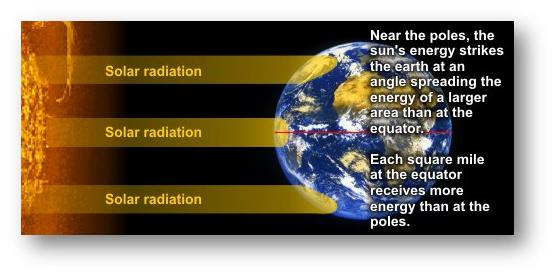
Source: http://www.srh.noaa.gov/jetstream/tropics/tropics_intro.htm
On Earth we notice the effects of varying insolation on our climate. Sunlight falls most directly on the equator, and only obliquely (at an angle) at the poles. This means that sunlight is more concentrated at the equator. As shown in the above figure, the same amount of energy covers twice as much area when it strikes at an angle of 30 degrees compared to when it strikes a surface directly. The energy striking the Earth indirectly has less ability to warm the Earth because there is less energy per unit of surface area than when the sunlight strikes the surface of the Earth more directly.
This difference explains why the equator has a hot climate and the poles have a cold climate. Differences in insolation also explain the existence of seasons.
For many years now, satellites have been monitoring these energy flows using spectrometers that measure the intensity of energy at different wavelengths flowing to the Earth and from the Earth.
The image below shows the insolation at the top of the atmosphere averaged for the month of March.
Approximately 49% of the insolation is absorbed by the Earth’s surface:
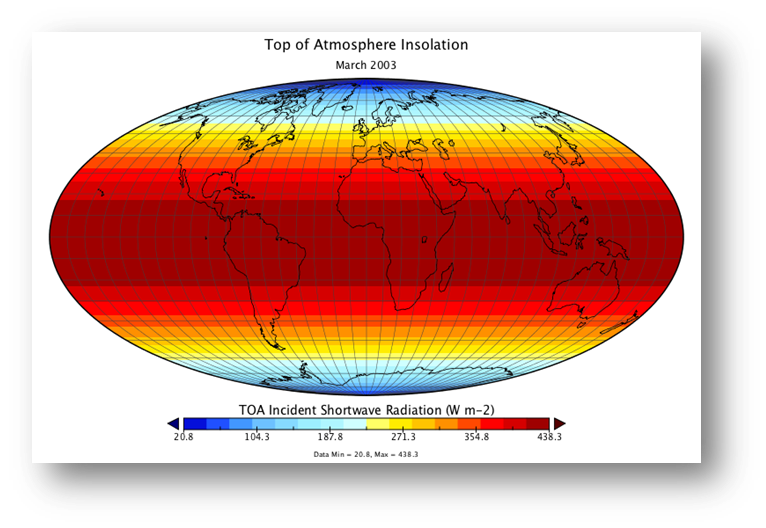
Source: https://www.e-education.psu.edu/earth103/node/1007
The Earth’s orbit around the sun is not perfectly circular so sometimes the earth is closer or further from the Sun. This also changes the amount of insolation, as the closer the Earth is to the Sun the more concentrated the solar radiation. Earth’s orbit is also not fixed, it changes over time. These changes are referred to as Milankovitch Cycles (changing the total insolation and the timing of the insolation).
These orbital variations have made a big difference in conditions on the Earth during the period in which humans have inhabited it.
Energy Flows in the Climate System
The view of the climate system depicted in the figure below is one of stability —energy flows in and out, in perfect balance, so the temperature of the earth should stay the same.
But if we can learn anything from studying Earth’s history, we learn that change is the rule and stability the exception. When change occurs, it almost always brings feedback mechanisms into play — they can accentuate and dampen change and they are incredibly important to our climate system.

Source: https://www.e-education.psu.edu/earth103/node/1007
Albedo
One way to change how quickly energy exits the Earth system is to change the reflectivity of the surface.
Compare the difference in darker surfaces to the brightness of snow‐covered ice.
The dark surface is going to absorb the sun’s rays (and heat the Earth’s surface) while the snow is reflecting the sunlight back into space.
Albedo is a measure of how reflective a surface is (higher the albedo = the more reflective).
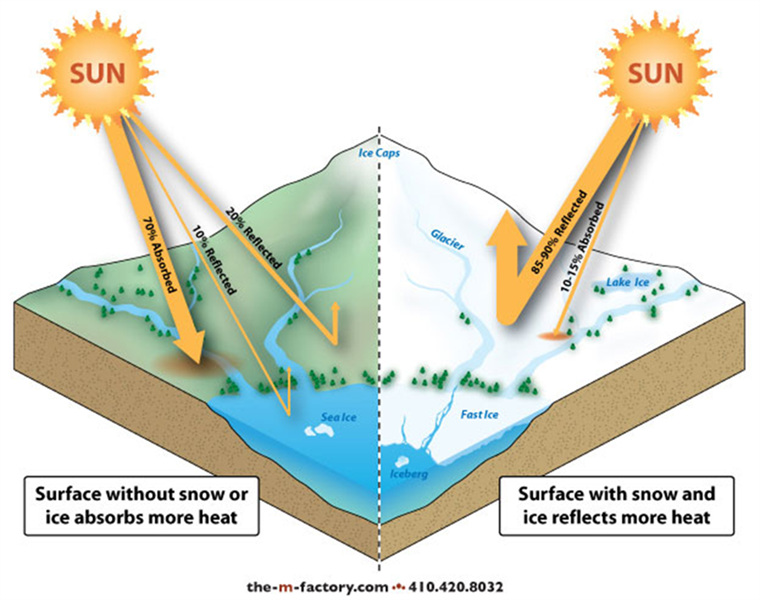
Source: http://oceanbites.org/sea-ice-and-albedo-should-we-be-worried/
The video below provides an explanation of the albedo effect.
Changes in albedo can create a positive feedback that reinforces a change in the climate. A positive feedback is a process which amplifies the effect of an initial change.
POSITIVE FEEDBACK MECHANISM

If the climate cools (initial change), snow covers more of the surface. Because snow has a higher albedo than bare ground, this initial cooling increased the amount of sunlight that is reflected back into space, cooling the Earth further.
If such a loop continued for long enough, this process could result in the entire Earth being covered in ice.
Since this chain of events furthers the initial change that triggered the whole thing, it is called a positive feedback (but note that the change may not be good from our perspective). Positive feedback mechanisms tend to lead to runaway change — some small initial change is thus accentuated into a major change.
In the Earth system, positive and negative feedbacks are essential components that play an important role in maintaining a more or less stable state. A negative feedback mechanism stabilizes a system, preventing an extreme state.
NEGATIVE FEEDBACK MECHANISM
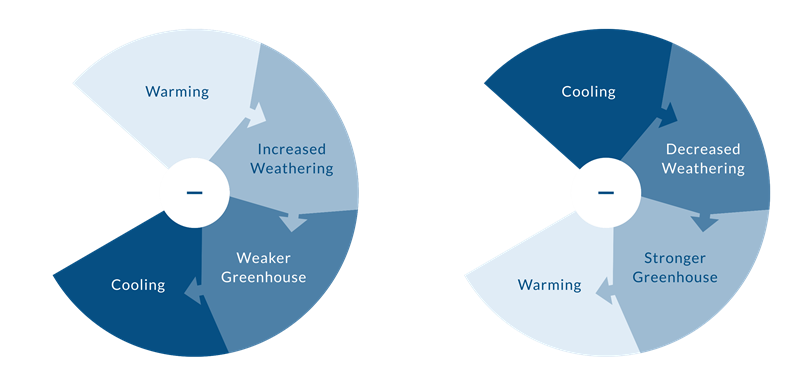
Weathering Feedback
Rocks exposed at earth’s surface interact with water and the atmosphere undergoing a set of chemical and physical changes called weathering.
The weathering process involves a chemical reaction. When carbon dioxide dissolves in water, carbonic acid is formed. Acid rain contains carbonic acid and when it falls on rocks sensitive to carbonic acid, another chemical reaction is initiated, dissolving minerals and breaking down the structure of the rocks. In this way, the atmospheric carbon is transported by rivers into oceans where it is trapped for thousands of years before it is returned to the atmosphere or stored in marine sediments or corals.
This process of weathering is thus a sink for atmospheric carbon dioxide, which is an important greenhouse gas. If you remove carbon dioxide from the atmosphere, you weaken the greenhouse effect and this leads to cooling of the Earth.
Like many chemical reactions, this chemical weathering occurs more rapidly in hotter climates, which are associated with higher levels of carbon dioxide. So consider a scenario in which some warming occurs; this will encourage faster weathering, which will consume carbon dioxide, which will lead to cooling. In this case, the initial change triggered a set of processes that countered the initial change — this is called a negative feedback (even though it may have beneficial results) because it works in opposition to the change that triggered it.
In the Classroom
Climate System
The Department of Geosciences at Georgia State University has published a set of labs that may be helpful. Of particular interest is Lab 5 Global Surface Temperature http://sites.gsu.edu/geog1112/global-surface-temperature/
More Information and Resources
Climate System
- Video released by Yale Climate Connections This Is Not Cool http://www.yaleclimateconnections.org/2013/11/new-ipcc-report-featured-in-this-months-this-is-not-cool-video/
- IPCC Fifth Assessment Report is available here http://www.ipcc.ch/
- This IPCC Report provides information about observed changes in the climate system http://www.climatechange2013.org/images/report/WG1AR5_SPM_FINAL.pdf
- A University of British Columbia online course http://www.youtube.com/user/climateliteracy Of particular interest related to this section are the following:
- Module 2 Introduction to the Climate System https://www.youtube.com/playlist?list=PLAHtWWrZTgn-i_U-ft6cjsTj2faylPSJO
- Module 3 Earth's Energy Balance https://www.youtube.com/playlist?list=PLAHtWWrZTgn8boLKB4-a1PV5y_u_b0MJU
- 100 Views of Climate Change, Colorado State University http://changingclimates.colostate.edu/
